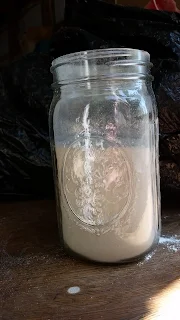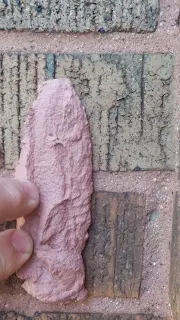 |
| Two views of the same Japanese Beetle trap. The vines arching over the fence are wild grapes. It will not bother me if the Japanese Beetles munch on them. |
 |
| Another mess of wild grapes about sixty yards to the north of the others. |
The strategy I am using this year is to spray the domestic grape vines with an insecticide and to put JB traps near vines I am willing to sacrifice. Think of the sacrifice vines as a pressure relief valve. The picture in my head is that the vines with the traps will become lighthouses calling in the vast majority of the JBs. The few that are pulled into the cultivated grapes should die a quick death.
Once I get a good load of JB in those grape vines and spewing pheromones I will move the traps (I bought two) to another set of vines or weeds known to attract JBs. It is a bit like battle plans. Get the enemy where you want them and hide your vulnerabilities
Mortar mix
Randy is one of my coffee-drinking friends. He was a builder by trade. He started out as a brick layer. When I needed advice on repointing the brick on mom-and-dad's chimney, I went to him and asked.
The first thing he told me was that standard mortar mix is not sticky enough. The key is to add either a big trowel-full of Portland cement powder per bag of mortar mix or a heaping trowel-full of slaked lime per bag.
That seemed hardly believable, that major cement manufactures would sell mortar mix short of cement powder.
Imagine my surprise when most of the internet agrees with Randy. Historically the "proper" mix was considered three parts sand and one part lime.
The head-fake is that there are three kinds of lime. There is "burnt lime" which is what the historical documents referred to. There is "slaked lime" which is what is commonly sold today. There is powdered limestone which is what gardeners use.
The problem is that slaked lime is much fluffier than burnt lime. A ratio of one part burnt lime to three parts sand is the equivalent of one part slaked lime to two parts sand. The mix sold by cement companies may work just fine for building new cinder-block walls but has the wrong consistency for repointing/tucking work.
The higher sand mix is less plastic and not nearly as sticky. It does not want to wet the mortar/brick joint and it wants to roll out of the joint when you press it in with your tucking tool.
 |
| About 18 ounces of "N" mortar mix by volume. The level of mortar mix in the jar is 4". "N" is the Normal mix for outdoor use. The binder is half slaked lime and half Portland cement. The slaked lime makes this mix caustic and one must either wear PPE or wash hands frequently. One curiosity of N mix is that it takes a long time to reach full strength. |
Since I am going to nibble at this project, I decided to add the extra slaked lime ahead of time and seal it in quart jars. Mortar mix is a perishable commodity. The humidity and Carbon Dioxide in the air ages it.
 |
| Shaken up to mix and sealed. I really think there is a market for premixes like this. They do it for pancake mix. Why not mortar? |
Playing around with the premixed batches I found that I need just a wee bit less than 8 ounces of water. I found that eight ounces made the mix very sticky (good) but a little too slumpy (not good).
 |
| Second try. 16 oz dye in four gallon of water. Close enough. |




Excellent point, I never thought about the different types of lime in mortar.
ReplyDeleteThis one is going to need linking to - Jap beetles indeed.
ReplyDeleteI'll pay for beer if you come over and help me out on my brickwork. Pugsley RAN A CAR into my house and now I have about 10' of mortar that needs to be . . . matched.
ReplyDelete